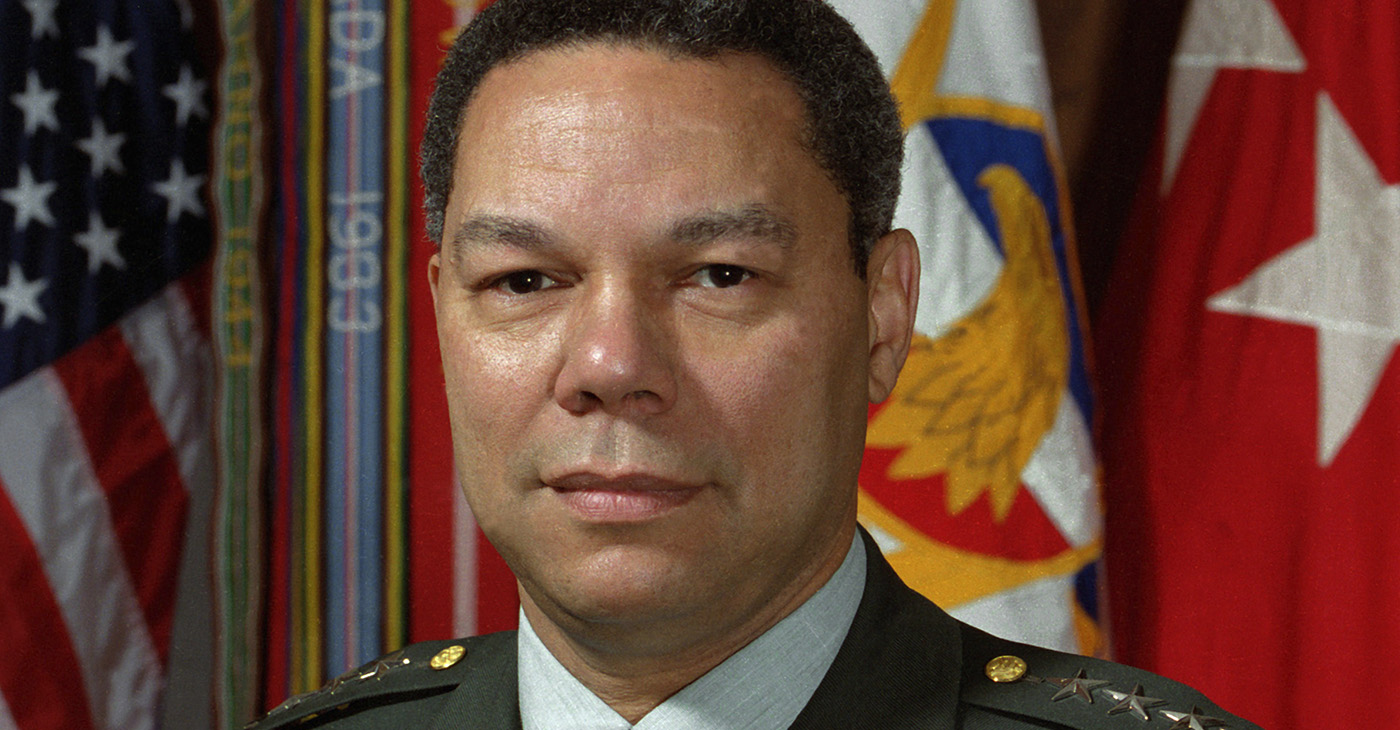Black History
Colin Powell: ‘Not Allowed to Fail’
Via jobs as military assistant to high-level government officials and a stint as national security adviser to then-President Ronald Reagan, Powell rose quickly through the ranks. He became the youngest and first Black chairman of the Joint Chiefs. He was instrumental in the 1991 Persian Gulf War victory but struggled over the U.S. invasion of Iraq in 2003—at which time he was serving as secretary of state under then-President George W. Bush, Powell’s most difficult assignment.

By Tamara Shiloh
Gen. Colin Powell (1937–2021), born in Harlem to Jamaican immigrant parents Luther and Maud Powell, rose to the highest reaches of the U.S. military: four-star general. He would go on to become the country’s first Black Secretary of State. His successes weren’t without support and the foundation set early on.
Propelling Powell to exceed his own expectations were those of his parents: “We were not allowed to fail,” he said during a 2006 New York Daily News interview. Powell said those words “didn’t mean you had to be a general or a doctor or a lawyer. In fact, that was the furthest thing from my mind when I was a kid in New York City. But you had to stay in school, and you had to do well, and you had to meet (their) expectations: ‘We didn’t come to this country for the next generation to blow it.’”
Powell’s childhood was storied. Raised in a four-bedroom, third-floor apartment on Kelly Street in the South Bronx, Powell came from modest means. His father worked in Manhattan’s Garment District, and his mother was a seamstress. He often said that he loved his tenement neighborhood.
Surrounded by a large extended family as well as people of varied cultures, Powell described his childhood experiences in New York City as being exposed to “every type of person you could imagine,” and that it “meant so much to me as I grew up and learned the importance of diversity.”
Powell attended New York City’s public schools before enrolling at City College of New York and later earning an MBA from George Washington University. It was at City College that he found his calling: The Reserve Officer Training Corps program. He began to build relationships that later led him to the U.S. Army—a move that would eventually direct his future.
Via jobs as military assistant to high-level government officials and a stint as national security adviser to then-President Ronald Reagan, Powell rose quickly through the ranks. He became the youngest and first Black chairman of the Joint Chiefs. He was instrumental in the 1991 Persian Gulf War victory but struggled over the U.S. invasion of Iraq in 2003—at which time he was serving as secretary of state under then-President George W. Bush, Powell’s most difficult assignment.
As the Pentagon’s top officer, Powell, who viewed himself as a problem-solver, called for “applying military might only with overwhelming and decisive troop strength, a clear objective, and popular support,” the Washington Post reported. Journalists later dubbed this method “the Powell Doctrine.”
Interestingly, throughout his career, Powell avoided racial activism. He believed “race factored much less in his professional success than his ability to work within institutions, where he competed with whites on their own terms,” according to the Washington Post. “My race is somebody’s else’s problem … It’s not my problem,” he had said.
After retiring from public service, spending time on the lecture circuit, and becoming founding chair of America’s Promise, Powell died Oct. 18, 2021. He was 84.
Activism
Oakland Post: Week of April 24 – 30, 2024
The printed Weekly Edition of the Oakland Post: Week of April 24 – 30, 2024

To enlarge your view of this issue, use the slider, magnifying glass icon or full page icon in the lower right corner of the browser window. ![]()
Activism
Oakland Post: Week of April 17 – 23, 2024
The printed Weekly Edition of the Oakland Post: Week of April 17 – 23, 2024

To enlarge your view of this issue, use the slider, magnifying glass icon or full page icon in the lower right corner of the browser window. ![]()
Black History
Matthew Henson: Explorer Extraordinaire
Matthew Henson, a trailblazing explorer who overcame countless obstacles to leave an incredible mark on history. Born on August 8, 1866, in Charles County, Maryland, his journey is a testament to the power of determination and the spirit of adventure.

By Tamara Shiloh
Matthew Henson, a trailblazing explorer who overcame countless obstacles to leave an incredible mark on history. Born on August 8, 1866, in Charles County, Maryland, his journey is a testament to the power of determination and the spirit of adventure.
Henson’s life began amidst the backdrop of post-Civil War America, where opportunities for African Americans were scarce. From a young age, he possessed an insatiable curiosity about the world beyond his small town. At the age of 12, he embarked on a journey that would change the course of his life forever when he joined a merchant ship as a cabin boy.
His most famous expedition was his journey to the Arctic with renowned explorer Robert E. Peary. In 1887, Henson joined Peary’s crew as a seaman and quickly proved himself to be invaluable with his skills as a navigator and craftsman. Over the course of several expeditions, Matthew endured extreme cold, treacherous terrain, and grueling conditions as he and Peary sought to reach the elusive North Pole.
In 1908–09, Peary set out on his eighth attempt to reach the North Pole. It was a big expedition, with Peary planning to leave supplies along the way. When he and Henson boarded their ship, the Roosevelt, leaving Greenland on August 18, 1909, they were joined by a large group. This included 22 Inuit men, 17 Inuit women, 10 children, 246 dogs, 70 tons of whale meat, blubber from 50 walruses, hunting gear, and tons of coal.
In February, Henson and Peary left their anchored ship at Ellesmere Island’s Cape Sheridan, along with the Inuit men and 130 dogs. They worked together to set up a trail and supplies along the way to the Pole.
Peary picked Henson and four Inuit people to join him in the final push to the Pole. However, before they reached their destination, Peary couldn’t walk anymore and had to ride in a dog sled. He sent Henson ahead to scout the way. In a later interview with a newspaper, Henson recalled being in the lead and realizing they had gone too far. The group turned back, and Henson noticed his footprints helped guide them to their destination. At that location, Henson planted the American flag.
Henson’s legacy extends far beyond his expeditions to the Arctic. He shattered racial barriers in the world of exploration and inspired countless individuals, regardless of race, to dream big and pursue their passions. In 1937, he was finally recognized for his achievements when he was inducted into The Explorers Club, an organization dedicated to promoting scientific exploration and field research.
Matthew Henson died in the Bronx, New York, on March 9, 1955, at the age of 88.
-

 Community2 weeks ago
Community2 weeks agoFinancial Assistance Bill for Descendants of Enslaved Persons to Help Them Purchase, Own, or Maintain a Home
-

 Activism3 weeks ago
Activism3 weeks agoOakland Post: Week of April 3 – 6, 2024
-

 Business2 weeks ago
Business2 weeks agoV.P. Kamala Harris: Americans With Criminal Records Will Soon Be Eligible for SBA Loans
-

 Community2 weeks ago
Community2 weeks agoAG Bonta Says Oakland School Leaders Should Comply with State Laws to Avoid ‘Disparate Harm’ When Closing or Merging Schools
-

 Activism2 weeks ago
Activism2 weeks agoOakland Post: Week of April 10 – 16, 2024
-

 Community1 week ago
Community1 week agoOakland WNBA Player to be Inducted Into Hall of Fame
-

 Community1 week ago
Community1 week agoRichmond Nonprofit Helps Ex-Felons Get Back on Their Feet
-

 City Government2 weeks ago
City Government2 weeks agoLAO Releases Report on Racial and Ethnic Disparities in California Child Welfare System























































